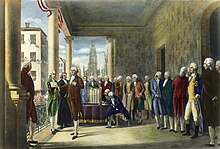| Federalist Era | |||
|---|---|---|---|
| 1788–1800 | |||
 Washington's first inauguration | |||
| Location | United States | ||
| Leader(s) | George Washington John Adams Alexander Hamilton John Jay | ||
| Key events | Whiskey Rebellion Quasi-War Jay Treaty Northwest Indian War Bill of Rights Alien and Sedition Acts Bank Bill of 1791 Coinage Act of 1792 | ||
Chronology
| |||
| This article is part of a series on the |
| History of the United States |
|---|
 |
The Federalist Era in American history ran from 1788 to 1800, a time when the Federalist Party and its predecessors were dominant in American politics. During this period, Federalists generally controlled Congress and enjoyed the support of President George Washington and President John Adams. The era saw the creation of a new, stronger federal government under the United States Constitution, a deepening of support for nationalism, and diminished fears of tyranny by a central government. The era began with the ratification of the United States Constitution and ended with the Democratic-Republican Party's victory in the 1800 elections.
During the 1780s, the "Confederation Period", the new nation functioned under the Articles of Confederation, which provided for a loose confederation of states. At the 1787 Philadelphia Convention, delegates from most of the states wrote a new constitution that created a more powerful federal government. After the convention, this constitution was submitted to the states for ratification. Those who advocated ratification became known as Federalists, while those opposed to ratification became known as anti-Federalists. After the Federalists won the ratification debate in all but two states, the new constitution took effect and new elections were held for Congress and the presidency. The first elections returned large Federalist majorities in both houses and elected George Washington, who had taken part in the Philadelphia Convention, as president. The Washington administration and the 1st United States Congress established numerous precedents and much of the structure of the new government. Congress shaped the federal judiciary with the Judiciary Act of 1789 while Treasury Secretary Alexander Hamilton's economic policies fostered a strong central government. The first Congress also passed the United States Bill of Rights to constitutionally limit the powers of the federal government. During the Federalist Era, American foreign policy was dominated by concerns regarding Britain, France, and Spain. Washington and Adams sought to avoid war with each of these countries while ensuring continued trade and settlement of the American frontier.[1]
Hamilton's policies divided the United States along factional lines, creating voter-based political parties for the first time. Hamilton mobilized urban elites who favored his financial and economic policies. His opponents coalesced around Thomas Jefferson and James Madison. Jefferson feared that Hamilton's policies would lead to an aristocratic, and potentially monarchical, society that clashed with his vision of a republic built on yeomen farmers. This economic policy debate was further roiled by the French Revolutionary Wars, as Jeffersonians tended to sympathize with France and Hamiltonians with Britain. The Jay Treaty established peaceful commercial relations with Britain, but outraged the Jeffersonians and damaged relations with France. Hamilton's followers organized into the Federalist Party while the Jeffersonians organized into the Democratic-Republican Party. Though many who had sought ratification of the Constitution joined the Federalist Party, some advocates of the Constitution, led by Madison, became members of the Democratic-Republicans. The Federalist Party and the Democratic-Republican Party contested the 1796 presidential election, with the Federalist Adams emerging triumphant. From 1798 to 1800, the United States engaged in the Quasi-War with France, and many Americans rallied to Adams. In the wake of these foreign policy tensions, the Federalists imposed the Alien and Sedition Acts to crack down on dissidents and make it more difficult for immigrants to become citizens. Historian Carol Berkin argues that the Federalists successfully strengthened the national government, without arousing fears of tyranny.[2]
The Federalists embraced a quasi-aristocratic, elitist vision that was unpopular with most Americans outside of the middle class. Jefferson's egalitarian vision appealed to farmers and middle-class urbanites alike and the party embraced campaign tactics that mobilized all classes of society. Although the Federalists retained strength in New England and other parts of the Northeast, the Democratic-Republicans dominated the South and West and became the more successful party in much of the Northeast. In the 1800 elections, Jefferson defeated Adams for the presidency and the Democratic-Republicans took control of Congress. Jefferson accurately referred to the election as the "Revolution of 1800", as Jeffersonian democracy came to dominate the country in the succeeding decades. The Federalists experienced a brief resurgence during the War of 1812, but collapsed after the war. Despite the Federalist Party's demise, many of the institutions and structures established by the party would endure, and Hamilton's economic policies would influence generations of American political leaders.[3]
- ^ Gordon S. Wood, Empire of liberty: a history of the early Republic, 1789–1815 (2009) pp 1–52.
- ^ Krischer, Elana (March 2019). "Review of Berkin, Carol, A Sovereign People: The Crises of the 1790s and the Birth of American Nationalism". H-War, H-Net Reviews. Archived from the original on 2020-09-01. Retrieved 2019-04-03.
- ^ Peter S. Onuf, Jan Lewis, and James P.P. Horn, eds. The Revolution of 1800: Democracy, Race, and the New Republic (U of Virginia Press, 2002).
© MMXXIII Rich X Search. We shall prevail. All rights reserved. Rich X Search
